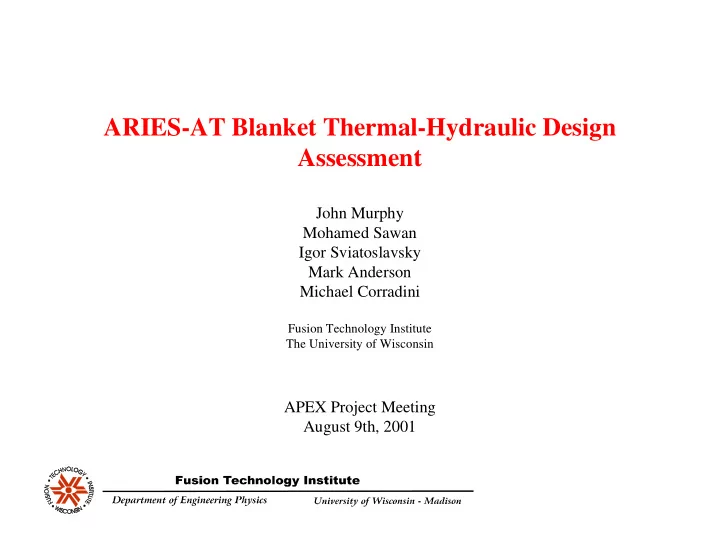

ARIES-AT Blanket Thermal-Hydraulic Design Assessment John Murphy Mohamed Sawan Igor Sviatoslavsky Mark Anderson Michael Corradini Fusion Technology Institute The University of Wisconsin APEX Project Meeting August 9th, 2001
Overview Calculation of blanket ∆ T performed • – Compared to previous ARIES-AT estimate – Bulk heating compared favorably (within 3% deviation) -- Surface heating needs to be examined further • Updated analysis will be performed with APEX heating values – MHD pressure drops estimated and used to size coolant flow rates – SiC/SiC temperature limits utilized for flow rate calculation • Heat loads balanced against cooling requirements to determine feasibility of advanced APEX designs
Configuration of First Wall and Pb-17Li Blanket • First wall configuration with Pb-17Li flows • Pb-17Li flow paths – Front: 3 sections • 0.4 cm X 7 cm – Back: 13 sections • 0.4 cm X 1.4 cm – Side: 8 sections • 0.4 cm X 5 cm – Middle: 1 section • 17.8 cm X 24.5 cm • Pb-17Li flows up the front, back and side channels, then downward through the large central channel and out of the blanket
Calculation of Pb-17Li Blanket � T • Slug flow velocity profiles used for the Pb-17Li molten metal – Flow velocities taken from ARIES-AT study – Slug flow confirmed by MHD analysis at UCLA – Upward side flow velocities estimated by averaging front and back • Blanket assumed to be 8 meters tall, with molten metal used as the heat sink • As slug of metal moves vertically in the blanket its exposure time to the heat loads must be estimated – This value is the distance it moves (~ 8 m) divided by its velocity – Flow exposure times • front flow ~ 2 seconds • side flow ~ 3.29 seconds • back flow ~ 12.1 seconds • middle flow (downward) ~ 72.7 seconds
Calculation of Pb-17Li Blanket � T (continued) • The exposure time and heating loads are used to determine the energy deposited to the slug of fluid and its subsequent temperature change ρ C p ∆ Temperature (Volume) = Heating Rate ( ∆ Time) � • Variable exposure times are used for each slug of metal mass, depending which section of the blanket it resides in • All heat deposited to the SiC/SiC structure is transferred into the adjacent Pb- 17Li flow, heating of structure between up and downward flows is split evenly • Surface heat loads are applied to the first wall, along with nuclear heating loads at various radial positions – 80 % of maximum values used as a reasonable average – Nuclear heating values were used from a blanket study of the ARIES-AT (ranged from 24 to 2 W/cm 3 ) Surface heating of first wall was estimated at maximum of 0.34 Mw/m 2 –
Calculation of Pb-17Li Blanket � T (continued) • Based on the heat loading values and fluid exposure times an estimate of the Pb-17Li temperature change could be made • The flow upward moving flow gained 66.3 C, while the downward moving flow gained 281.7 C – The downward flow has lower nuclear heating densities but significantly longer exposure times to the loads, hence the larger temperature change • Total blanket Pb-17Li temperature rise of 348.0 C • The previous ARIES-AT study gave a value of 336 C for the outboard blanket region (~ 3 % difference) • Methodology has been confirmed and will be used to determine Pb-17Li blanket temperature change for higher APEX heat loads
Calculation of SiC/SiC Max Blanket � emperature • Comparison of SiC/SiC maximum temperature estimate to ARIES-AT result • First Position - Top of OB First Wall facing plasma where FW molten metal is at highest T: – (T max - T bulk )= Q” ( δ/Κ wall + D h /Nu*K metal ) [ T max = 950 C (for Nu = 4.36)] ( THIS COMPARES TO 995 C for ARIES AT ANALYSIS) • Second Position - Bottom of Inner Annulus at the outlet metal temperature – (T out - T inner ) = (Inner HT conductance)/(Total HT conductance)*(T out -T inlet ) – T inner = 1035 C ( THIS COMPARES TO 996 C for ARIES AT ANALYSIS) More detailed conduction calculations underway to refine estimate
APEX Modified Heat Load Calculation of Pb-17Li Blanket � T • Modified heat loads will be used to determine the heating of the Pb-17Li metal and the first wall for the APEX blanket study • New Pb-17Li flow rates will be calculated utilizing MHD pressure drop estimates – Flow rates are to be based on the cooling requirements for the SiC/SiC blanket • The new temperature change in the blanket will be useful in determining the viability of expanding the operating zone for the ARIES-AT design • Future work – Calculate temperature of Pb-17Li under “swirl” flow conditions – Determine max SiC/SiC temperature under above described conditions
Recommend
More recommend